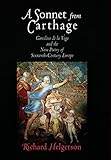A Sonnet from Carthage : Garcilaso de la Vega and the New Poetry of Sixteenth-Century Europe / Richard Helgerson.
Material type: TextPublisher: Philadelphia : University of Pennsylvania Press, [2015]Copyright date: ©2007Description: 1 online resource (144 p.)Content type:
TextPublisher: Philadelphia : University of Pennsylvania Press, [2015]Copyright date: ©2007Description: 1 online resource (144 p.)Content type: - 9780812240047
- 9780812292367
- 861/.3
- PQ6393.G3 ǂb Z64 2007eb
- online - DeGruyter
- Issued also in print.
| Item type | Current library | Call number | URL | Status | Notes | Barcode | |
|---|---|---|---|---|---|---|---|
 eBook
eBook
|
Biblioteca "Angelicum" Pont. Univ. S.Tommaso d'Aquino Nuvola online | online - DeGruyter (Browse shelf(Opens below)) | Online access | Not for loan (Accesso limitato) | Accesso per gli utenti autorizzati / Access for authorized users | (dgr)9780812292367 |
Browsing Biblioteca "Angelicum" Pont. Univ. S.Tommaso d'Aquino shelves, Shelving location: Nuvola online Close shelf browser (Hides shelf browser)

|

|

|

|

|

|

|
||
| online - DeGruyter The Prehistory of the Silk Road / | online - DeGruyter Medicine Bundle : Indian Sacred Performance and American Literature, 1824-1932 / | online - DeGruyter The Romance of the Rose or Guillaume de Dole / | online - DeGruyter A Sonnet from Carthage : Garcilaso de la Vega and the New Poetry of Sixteenth-Century Europe / | online - DeGruyter William Langland's "Piers Plowman" : The C Version. | online - DeGruyter Dreiser's Russian Diary / | online - DeGruyter Remediation in Rwanda : Grassroots Legal Forums / |
Frontmatter -- Contents -- Preface. Diagnosis for an Essay -- Part I. A Sonnet from Carthage -- Sonnet to Boscán from Goleta -- 1. What They Expected (. . . and What They Got) -- 2. Las armas y el furor de Marte / Arms and the fury of Mars -- 3. El arte italïano / Italian art -- 4. Aquí / Here -- 5. Me deshago / I am undone -- 6. Boscán / Boscán -- Epilogue: Poetry of the New -- Part II. Garcilaso's Tunisian Poems: A Bilingual Anthology -- Garcilaso's Tunisian Poems: A Bilingual Anthology -- Epístola a Boscán / Epistle to Boscán -- Soneto a Mario / Sonnet to Mario -- Elegía a Boscán / Elegy to Boscán -- Elegía al duque d'Alva / Elegy to the Duke of Alba -- Ode ad Genesium Sepulvedam / Ode to Ginés de Sepúlveda -- Bibliography -- Acknowledgments
restricted access online access with authorization star
http://purl.org/coar/access_right/c_16ec
In 1492 the Spanish humanist Antonio de Nebrija proclaimed that "language has always been the companion of empire." Taking as his touchstone a wonderfully suggestive sonnet that Garcilaso de la Vega wrote in 1535 from the neighborhood of ruined Carthage in North Africa, Richard Helgerson examines how the companionship of language and empire played itself out more generally in the "new poetry" of sixteenth-century Europe. Along with his friend Juan Boscán, Garcilaso was one of the great pioneers of that poetry, radically reforming Spanish verse in imitation of modern Italian and ancient Roman models. As the century progressed, similar projects were undertaken in France by Ronsard and du Bellay, in Portugal by Camões, and in England by Sidney and Spenser. And wherever the new poetry emerged, it was prompted by a sense that imperial ambition-the quest to be in the present what Rome had been in the past-required a vernacular poetry comparable to the poetry of Rome.But, as Helgerson shows, the new poetry had other commitments than to empire. Though imperial ambition looms large in Garcilaso's sonnet and others, by the end of the poem Garcilaso identifies not with Rome but with the Carthaginian queen Dido, one of empire's legendary victims. And with this startling shift, which has its counterpart in poems from all over Europe, comes one of the most important departures the poem makes from its apparent imperial agenda.Addressing these rival concerns as they arise in a single sonnet, Richard Helgerson provides a masterful and multifaceted image of one of the most vital episodes in European literary history.
Issued also in print.
Mode of access: Internet via World Wide Web.
In English.
Description based on online resource; title from PDF title page (publisher's Web site, viewed 24. Apr 2022)


